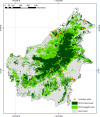Long-term carbon sink in Borneo's forests halted by drought and vulnerable to edge effects
- PMID: 29259276
- PMCID: PMC5736600
- DOI: 10.1038/s41467-017-01997-0
Long-term carbon sink in Borneo's forests halted by drought and vulnerable to edge effects
Erratum in
-
Author Correction: Long-term carbon sink in Borneo's forests halted by drought and vulnerable to edges.Nat Commun. 2018 Jan 19;9(1):342. doi: 10.1038/s41467-018-02920-x. Nat Commun. 2018. PMID: 29352254 Free PMC article.
Abstract
Less than half of anthropogenic carbon dioxide emissions remain in the atmosphere. While carbon balance models imply large carbon uptake in tropical forests, direct on-the-ground observations are still lacking in Southeast Asia. Here, using long-term plot monitoring records of up to half a century, we find that intact forests in Borneo gained 0.43 Mg C ha-1 per year (95% CI 0.14-0.72, mean period 1988-2010) above-ground live biomass. These results closely match those from African and Amazonian plot networks, suggesting that the world's remaining intact tropical forests are now en masse out-of-equilibrium. Although both pan-tropical and long-term, the sink in remaining intact forests appears vulnerable to climate and land use changes. Across Borneo the 1997-1998 El Niño drought temporarily halted the carbon sink by increasing tree mortality, while fragmentation persistently offset the sink and turned many edge-affected forests into a carbon source to the atmosphere.
Conflict of interest statement
The authors declare no competing financial interests.
Figures






References
-
- Ciais, P. et al. in Climate Change 2013: The Physical Science Basis. Contribution of Working Group I to the Fifth Assessment Report of the Intergovernmental Panel on Climate Change (eds Thomas F. Stocker et al) 465–570 (Cambridge University Press, 2013).
-
- Zhu Z, et al. Greening of the Earth and its drivers. Nat. Clim. Change. 2016;6:791–795. doi: 10.1038/nclimate3004. - DOI
-
- Sitch S, et al. Recent trends and drivers of regional sources and sinks of carbon dioxide. Biogeosciences. 2015;12:653–679. doi: 10.5194/bg-12-653-2015. - DOI
Publication types
LinkOut - more resources
Full Text Sources
Other Literature Sources
Research Materials

